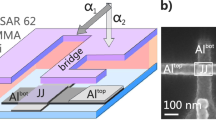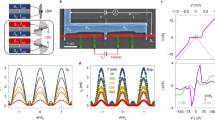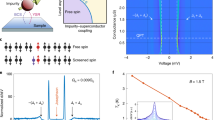Abstract
Josephson junctions are a central element in superconducting quantum technology; in these devices, irreversibility arises from abrupt slips of the quantum phase difference across the junction. This phase slip is often visualized as the tunnelling of a flux quantum in the transverse direction to the superconducting weak link, which produces dissipation. Here we detect the instantaneous heat release caused by a phase slip in a Josephson junction, signalled by an abrupt increase in the local electronic temperature in the weak link and subsequent relaxation back to equilibrium. Beyond the advance in experimental quantum thermodynamics of observing heat in an elementary quantum process, our approach could allow experimentally investigating the ubiquity of dissipation in quantum devices, particularly in superconducting quantum sensors and qubits.
This is a preview of subscription content, access via your institution
Access options
Access Nature and 54 other Nature Portfolio journals
Get Nature+, our best-value online-access subscription
$29.99 / 30 days
cancel any time
Subscribe to this journal
Receive 12 print issues and online access
$209.00 per year
only $17.42 per issue
Buy this article
- Purchase on Springer Link
- Instant access to full article PDF
Prices may be subject to local taxes which are calculated during checkout



Similar content being viewed by others
Data availability
The datasets plotted in this work are available via Zenodo at https://zenodo.org/record/6389955. The raw datasets are large files and can be obtained from the corresponding author upon request.
References
Mooij, J. E. & Harmans, C. J. P. M. Phase-slip flux qubits. New J. Phys. 7, 219 (2005).
Mooij, J. E. & Nazarov, Yu. V. Superconducting nanowires as quantum phase-slip junctions. Nat. Phys. 2, 169–172 (2006).
Liebermann, P. J. & Wilhelm, F. K. Optimal qubit control using single-flux quantum pulses. Phys. Rev. Appl. 6, 024022 (2016).
Leonard, E. et al. Digital coherent control of a superconducting qubit. Phys. Rev. Appl. 11, 014009 (2019).
Howington, C. et al. Interfacing superconducting qubits with cryogenic logic: readout. IEEE Trans. Appl. Supercond. 29, 1700305 (2019).
McDermott, R. et al. Quantum–classical interface based on single flux quantum digital logic. Quantum Sci. Technol. 3, 024004 (2018).
Chiorescu, I., Nakamura, Y., Harmans, C. J. P. & Mooij, J. E. Coherent quantum dynamics of a superconducting flux qubit. Science 299, 1869–1871 (2003).
Yan, F. et al. The flux qubit revisited to enhance coherence and reproducibility. Nat. Commun. 7, 12964 (2016).
Manucharyan, V. E., Koch, J., Glazman, L. I. & Devoret, M. H. Fluxonium: single Cooper-pair circuit free of charge offsets. Science 326, 113–116 (2009).
Nguyen, L. B. et al. High-coherence fluxonium qubit. Phys. Rev. X 9, 041041 (2019).
Astafiev, O. V. et al. Coherent quantum phase slip. Nature 484, 355–358 (2012).
Shaikhaidarov, R. S. et al. Quantized current steps due to the a.c. coherent quantum phase-slip effect. Nature 608, 45–49 (2022).
Golubev, D. S. & Zaikin, A. D. Quantum tunneling of the order parameter in superconducting nanowires. Phys. Rev. B 64, 014504 (2001).
Sahu, M. et al. Individual topological tunnelling events of a quantum field probed through their macroscopic consequences. Nat. Phys. 5, 503–508 (2009).
Tinkham, M. Introduction to Superconductivity 2nd edn (Dover, 1996).
van Der Wal, C. H. et al. Quantum superposition of macroscopic persistent-current states. Science 290, 773–777 (2000).
Friedman, J. R., Patel, V., Chen, W., Tolpygo, S. K. & Lukens, J. E. Quantum superposition of distinct macroscopic states. Nature 406, 43–46 (2000).
Likharev, K. K. Superconducting weak links. Rev. Mod. Phys. 51, 101 (1979).
Giazotto, F., Peltonen, J. T., Meschke, M. & Pekola, J. P. Superconducting quantum interference proximity transistor. Nat. Phys. 6, 254–259 (2010).
Courtois, H., Meschke, M., Peltonen, J. T. & Pekola, J. P. Origin of hysteresis in a proximity Josephson junction. Phys. Rev. Lett. 101, 067002 (2008).
Angers, L. et al. Proximity d.c. squids in the long-junction limit. Phys. Rev. B 77, 165408 (2008).
Dutta, B. et al. Single-quantum-dot heat valve. Phys. Rev. Lett. 125, 237701 (2020).
Schmidt, D. R., Yung, C. S. & Cleland, A. N. Nanoscale radio-frequency thermometry. Appl. Phys. Lett. 83, 1002–1004 (2003).
Gasparinetti, S. et al. Fast electron thermometry for ultrasensitive calorimetric detection. Phys. Rev. Appl. 3, 014007 (2015).
Karimi, B. & Pekola, J. P. Noninvasive thermometer based on the zero-bias anomaly of a superconducting junction for ultrasensitive calorimetry. Phys. Rev. Appl. 10, 054048 (2018).
Karimi, B. et al. Optimized proximity thermometer for ultrasensitive detection. Phys. Rev. Appl. 13, 054001 (2020).
Karimi, B., Brange, F., Samuelsson, P. & Pekola, J. P. Reaching the ultimate energy resolution of a quantum detector. Nat. Commun. 11, 367 (2020).
Zhou, F., Charlat, P., Spivak, B. & Pannetier, B. Density of states in superconductor-normal metal-superconductor junctions. J. Low Temp. Phys. 110, 841–850 (1998).
Le Sueur, H., Joyez, P., Pothier, H., Urbina, C. & Estève, D. Phase controlled superconducting proximity effect probed by tunneling spectroscopy. Phys. Rev. Lett. 100, 197002 (2008).
Ligato, N., Strambini, E., Paolucci, F. & Giazotto, F. Preliminary demonstration of a persistent Josephson phase-slip memory cell with topological protection. Nat. Commun. 12, 5200 (2021).
Larkin, A. L. & Ovchinnikov, Yu. N. Quasiclassical method in the theory of superconductivity. Zh. Eksp. Teor. Fiz. 55, 2262–2272 (1968).
Usadel, K. D. Generalized diffusion equation for superconducting alloys. Phys. Rev. Lett. 25, 507 (1970).
Belzig, W., Wilhelm, F. K., Bruder, C., Schön, G. & Zaikin, A. D. Quasiclassical Green’s function approach to mesoscopic superconductivity. Superlattices Microstruct. 25, 1251 (1999).
Giazotto, F., Heikkilä, T. T., Luukanen, A., Savin, A. M. & Pekola, J. P. Opportunities for mesoscopics in thermometry and refrigeration: physics and applications. Rev. Mod. Phys. 78, 217 (2006).
Viisanen, K. L. & Pekola, J. P. Anomalous electronic heat capacity of copper nanowires at sub-kelvin temperatures. Phys. Rev. B 97, 115422 (2018).
Wang, L. B., Golubev, D. S., Galperin, Y. M. & Pekola, J. P. Dynamic thermal relaxation in metallic films at sub-kelvin temperatures. Preprint at https://arxiv.org/abs/1910.09448 (2019).
Pekola, J. P. & Karimi, B. Ultrasensitive calorimetric detection of single photons from qubit decay. Phys. Rev. X 12, 011026 (2022).
Braine, T. et al. Extended search for the invisible axion with the axion dark matter experiment. Phys. Rev. Lett. 124, 101303 (2020).
Acknowledgements
We acknowledge help from A. Théry and T. Crozes. The samples were fabricated at the Nanofab platform at Institut Néel. This work received support from the European Union under the Marie Skłodowska-Curie grant agreement no. 766025 (QuESTech), from the Agence Nationale de la Recherche under the program ‘Investissements d’avenir’ (ANR-15-IDEX-02) and the Laboratoire d’excellence LANEF (ANR-10-LABX-51-01), and from Deutsche Forschungsgemeinschaft (DFG; German Research Foundation) via SFB 1432 (project no. 425217212).
Author information
Authors and Affiliations
Contributions
E.G. performed the experiments, with the help of P.R. D.M. prepared the samples, with the help of E.G. and P.R. D.N. and W.B. performed the theoretical modelling. B.K., J.T.P. and J.P.P. developed and helped installing the RF thermometry methods. E.G. and C.B.W. conceived the experiment. C.B.W. conducted the research and wrote the manuscript, with input from all the authors. All the authors contributed to the discussions and interpretation of data.
Corresponding author
Ethics declarations
Competing interests
The authors declare no competing interests.
Peer review
Peer review information
Nature Physics thanks the anonymous reviewers for their contribution to the peer review of this work
Additional information
Publisher’s note Springer Nature remains neutral with regard to jurisdictional claims in published maps and institutional affiliations.
Supplementary information
Supplementary Information
Supplementary Figs. 1–18 and Sections I–VIII.
Source data
Source Data Fig. 2
Original data for Fig. 2b–e.
Source Data Fig. 3
Original data.
Rights and permissions
Springer Nature or its licensor (e.g. a society or other partner) holds exclusive rights to this article under a publishing agreement with the author(s) or other rightsholder(s); author self-archiving of the accepted manuscript version of this article is solely governed by the terms of such publishing agreement and applicable law.
About this article
Cite this article
Gümüş, E., Majidi, D., Nikolić, D. et al. Calorimetry of a phase slip in a Josephson junction. Nat. Phys. 19, 196–200 (2023). https://doi.org/10.1038/s41567-022-01844-0
Received:
Accepted:
Published:
Issue Date:
DOI: https://doi.org/10.1038/s41567-022-01844-0
This article is cited by
-
A SQUID cools down after a slip
Nature Physics (2023)



